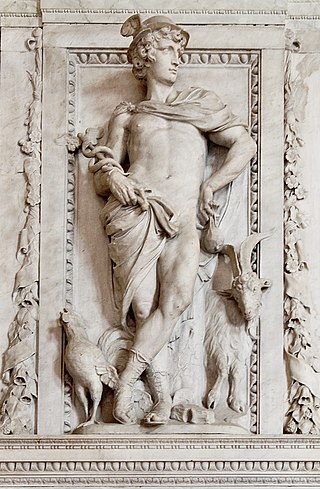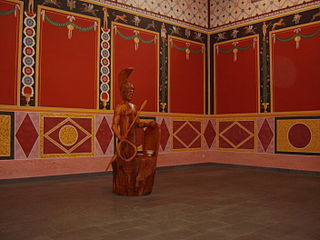Related Research Articles

Mercury is a major god in Roman religion and mythology, being one of the 12 Dii Consentes within the ancient Roman pantheon. He is the god of financial gain, commerce, eloquence, messages, communication, travelers, boundaries, luck, trickery, and thieves; he also serves as the guide of souls to the underworld and the "messenger of the gods".

In Gallo-Roman religion, Ancamna was a goddess worshipped particularly in the valley of the river Moselle. She was commemorated at Trier and Ripsdorf as the consort of Lenus Mars, and at Möhn as the consort of Mars Smertulitanus. At Trier, altars were set up in honour of Lenus Mars, Ancamna and the genii of various pagi of the Treveri, giving the impression of Lenus Mars and Ancamna as tribal protectors honoured in an officially organized cult. Among the few statuettes left as votive offerings at the sanctuary of Mars Smertulitanus and Ancamna at Möhn is one of a genius cucullatus like those offered to the Xulsigiae at the Lenus Mars temple complex in Trier.
Condatis was an ancient Celtic deity worshipped primarily in northern Britain but also in Gaul. He was associated with the confluences of rivers, in particular within County Durham in the North of England. Condatis is known from several inscriptions in Britain and a single inscription found at Alonnes, Sarthe, France. In each case he is equated with the Roman god Mars.

In Gallo-Roman religion, Loucetios was a Gallic god known from the Rhine-Moselle region, where he was identified with the Roman Mars. Scholars have interpreted his name to mean ‘lightning’. Mars Loucetius was worshipped alongside the goddess Nemetona.

Nemetona, or 'she of the sacred grove', is a Celtic goddess with roots in northeastern Gaul. She is thought to have been the eponymous deity of the Germano-Celtic people known as the Nemetes; evidence of her veneration is found in their former territory along the Middle Rhine as well in the Altbachtal sanctuary in present-day Trier, Germany. She is also attested in Bath, England, where an altar to her was dedicated by a man of the Gallic Treveri people.
In Romano-British culture and Germanic polytheism, the Alaisiagae were a quartet of Celtic and Germanic goddesses deifying victory.
The Silures were a powerful and warlike tribe or tribal confederation of ancient Britain, occupying what is now south east Wales and perhaps some adjoining areas. They were bordered to the north by the Ordovices; to the east by the Dobunni; and to the west by the Demetae.

In the localised Celtic polytheism practised in Great Britain, Sulis was a deity worshiped at the thermal spring of Bath. She was worshiped by the Romano-British as Sulis Minerva, whose votive objects and inscribed lead tablets suggest that she was conceived of both as a nourishing, life-giving mother goddess and as an effective agent of curses invoked by her votaries.
In ancient Celtic polytheism, Latis is the name of two Celtic deities worshipped in Roman Britain. One is a goddess, the other a god, and they are both known from a single inscription each.

Gallo-Roman religion is a fusion of the traditional religious practices of the Gauls, who were originally Celtic speakers, and the Roman and Hellenistic religions introduced to the region under Roman Imperial rule. It was the result of selective acculturation.

Brigantia or Brigindo was a goddess in Celtic religion of Late Antiquity.

Venta Silurum was a town in Roman Britain (Britannia). The name Venta Silurum means "the town of the Silurēs", with the Silurēs being a powerful and warlike tribe. Today, it consists of remains in the village of Caerwent in Monmouthshire, southeast Wales. Much of it has been archaeologically excavated and the nearby Newport Museum has many of the finds on display.

Lenus was a Celtic god of healing, good fortune, and protection in battle, worshipped mainly in eastern Gaul, where he was almost always identified with the Roman god Mars.

Veraudunus is the name of a Celtic god known only from two votive inscriptions found in Luxembourg. One of these inscriptions suggests that ‘Veraudunus’ may have been an epithet of the important Treveran god Lenus Mars. In both inscriptions, Veraudunus is invoked along with Inciona.
Vellaunus is a Celtic god known from two inscriptions. He was equated to the Roman god Mercury.
Toutatis or Teutates is a Celtic god who was worshipped primarily in ancient Gaul and Britain. His name means "god of the tribe", and he has been widely interpreted as a tribal protector. According to Roman writer Lucan, the Gauls offered human sacrifices to him.

In ancient Roman religion and mythology, Mars is the god of war and also an agricultural guardian, a combination characteristic of early Rome. He is the son of Jupiter and Juno, and was pre-eminent among the Roman army's military gods. Most of his festivals were held in March, the month named for him, and in October, the months which traditionally began and ended the season for both military campaigning and farming.

The gods and goddesses of the pre-Christian Celtic peoples are known from a variety of sources, including ancient places of worship, statues, engravings, cult objects, and place or personal names. The ancient Celts appear to have had a pantheon of deities comparable to others in Indo-European religion, each linked to aspects of life and the natural world. Epona was an exception and retained without association with any Roman deity. By a process of syncretism, after the Roman conquest of Celtic areas, most of these became associated with their Roman equivalents, and their worship continued until Christianization. Pre-Roman Celtic art produced few images of deities, and these are hard to identify, lacking inscriptions, but in the post-conquest period many more images were made, some with inscriptions naming the deity. Most of the specific information we have therefore comes from Latin writers and the archaeology of the post-conquest period. More tentatively, links can be made between ancient Celtic deities and figures in early medieval Irish and Welsh literature, although all these works were produced well after Christianization.

Celtic mythology is the body of myths belonging to the Celtic peoples. Like other Iron Age Europeans, Celtic peoples followed a polytheistic religion, having many gods and goddesses. The mythologies of continental Celtic peoples, such as the Gauls and Celtiberians, did not survive their conquest by the Roman Empire, the loss of their Celtic languages and their subsequent conversion to Christianity. Only remnants are found in Greco-Roman sources and archaeology. Most surviving Celtic mythology belongs to the Insular Celtic peoples. They preserved some of their myths in oral lore, which were eventually written down by Christian scribes in the Middle Ages. Irish mythology has the largest written body of myths, followed by Welsh mythology.
References
- 1 2 3 4 RIB 309
- 1 2 RIB 949
- 1 2 3 d'Este, Sorita; Rankine, David (2007). The Isles of the Many Gods: An A-Z of the Pagan Gods & Goddesses of Ancient Britain worshipped during the First Millennium through to the Middle Ages. Avalonia. p. 173.
- 1 2 RIB 310
- ↑ Green, Miranda (1997). Dictionary of Celtic Myth and Legend. London: Thames and Hudson Ltd.
- ↑ Delamarre, Xavier (2003). Dictionnaire de la langue gauloise. Errance. p. 310.

